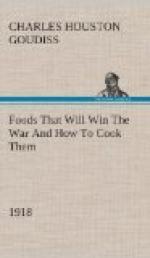Egg shells—after being used
to clear coffee.
Potato skins—after having been
cooked on the potato.
Banana skins—if there are no
tan shoes to be cleaned.
Bones—after having been boiled
in soup kettle.
Coffee grounds—if there is
no garden where they can be used for
fertilizer,
or if they are not desired as filling for
pincushions.
Tea leaves—after every tea-serving,
if they are not needed for
brightening
carpets or rugs when swept.
Asparagus ends—after being
cooked and drained for soup.
Spinach, etc.—decayed
leaves and dirty ends of roots.
If more than this is now thrown away, you are wasting the family income and not fulfilling your part in the great world struggle. Your government says that it is your business to know what food your family needs to be efficient; that you must learn how to make the most of the foods you buy; that it is your duty to learn the nature and uses of various foods and to get the greatest possible nourishment out of every pound of food that comes to your home.
The art of utilizing left-overs is an important factor in this prevention of waste. The thrifty have always known it. The careless have always ignored it. But now as a measure of home economy as well as a patriotic service, the left-over must be handled intelligently.
The following recipes show how to make appetizing dishes from products that heretofore in many homes have found their way to the extravagant pail.
In these recipes, sauces are prominent because they are of great value in making foods of neutral flavor, especially the starchy winter vegetables, and rice, macaroni and hominy, as attractive as they are nutritious; salads are included, since these serve to combine odds and ends of meats and vegetables; gelatine dishes are provided because gelatine serves as a binder for all kinds of leftovers and is an extremely practical way of making the most rigid saving acceptable; desserts made of crumbs of bread and cake, or left-over cereals, are among the major economies if they are worked out in such a way that they do not involve the extravagant use of other foodstuffs. All the recipes in this economy cook-book have been thoughtfully adapted to the conditions of the time, and will show the practical housekeeper how to supply wholesome, flavorsome food for the least cost.
* * * * *
SAUCES MAKE LEFTOVERS ATTRACTIVE
WHITE SAUCE
1/4 cup flour 1/4 cup fat 1 teaspoon salt 1/8 teaspoon cayenne 1-1/2 cups milk
Melt fat. Add dry ingredients and a little of the milk. Bring to boiling point. Continue adding milk a little at a time until all is added. Serve with vegetables, fish, eggs, meats.




